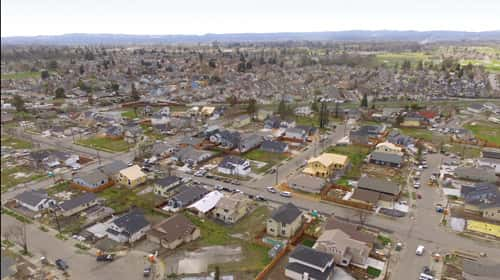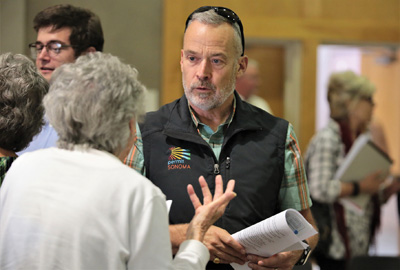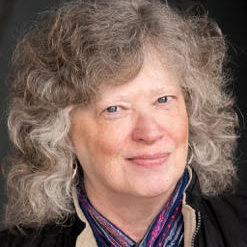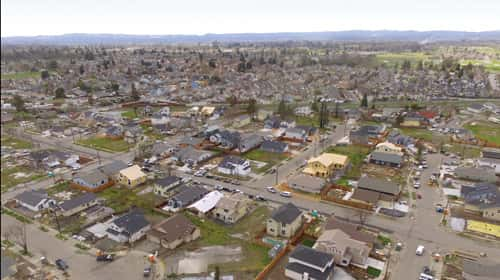Take a spin through Santa Rosa’s Coffey Park neighborhood and you’ll see what recovery and resiliency look like. Efforts to rebuild thousands of lost homes have ramped up to full speed in some areas of Sonoma County, with scenes of devastation from the Tubbs fire––and other fires that destroyed homes in the county in October 2017––quickly disappearing as new structures rise from the ashes.

“The rebuild rebound is officially underway,” says Keith Woods, chief executive officer, North Coast Builders Exchange. “I’m encouraged to see all the activity, but I’m also reminded that even if there are 1,000 more homes completed by the end of this year, that’s still less than 25 percent of all the homes needing to be rebuilt. At this current pace of activity, by the end of 2020, we might be near 40 percent rebuilt. I’m hoping we do even better than that.”
As the sounds of construction have amplified in Coffey Park, Larkfield-Wikiup and the Fountaingrove neighborhoods, rebuilds are coming online more quietly elsewhere in the county. Sonoma Valley lost hundreds of homes to the fire, but the terrain has had an impact on debris removal and has slowed efforts.
Permit processing
“The flatland areas are seeing the most rebuild activity because those are the easiest and less expensive to build on than a sloped lot in Fountaingrove or in Sonoma Valley,” says Woods. “We’re on our way back and building activity continues to spike, but it’s a slow process that requires patience on the part of those who lost homes and the community that wants to feel whole again. Patience is in short supply, and it’s understandable [as to] why.”
 Tennis Wick, director of Permit Sonoma, the county’s land use and planning agency, says he’s starting to see good progress in Sonoma Valley and is eager to work with property owners to continue that forward movement. In Glen Ellen, he says, permits have been issued for 11 accessory dwelling units (ADUs), one bridge (construction completed), and 65 homes. In Kenwood, permits have been issued for 10 ADUs and 45 homes (one is completed), and another nine homes in Sonoma have been issued permits.
Tennis Wick, director of Permit Sonoma, the county’s land use and planning agency, says he’s starting to see good progress in Sonoma Valley and is eager to work with property owners to continue that forward movement. In Glen Ellen, he says, permits have been issued for 11 accessory dwelling units (ADUs), one bridge (construction completed), and 65 homes. In Kenwood, permits have been issued for 10 ADUs and 45 homes (one is completed), and another nine homes in Sonoma have been issued permits.
Overall, says Wick, the county has issued permits for 979 housing units in unincorporated Sonoma County, with 51 of those completed. As of March 27, another 663 are currently in construction, 265 have permits issued with construction pending, and 118 are in permit review, yet to be issued.
David Rabbitt, chairman of the Sonoma County Board of Supervisors, praises Wick for stepping up and using the fire rebuilds as an example of how the permit process can be handled differently. “What we’ve learned since the fires is: if we can process a rebuilding permit in a matter of days, not weeks or months, why aren’t we doing that all the time? We made the process more difficult than it needed to be. Part of it is giving people the authority to make a decision instead of bogging it down with bureaucracy.”
Funding challenges
California’s new governor, Gavin Newsom, has an ambitious goal to build 3.5 million new housing units throughout the state during his term in office, according to Rabbitt. “That likely means new funds will be available to leverage funds raised at the local level,” he says. 
On last fall’s election ballot, Santa Rosa’s Measure N, a $124 million bond to increase the supply of affordable housing, failed to pass. Had it passed, it might have put the city in a better position to receive matching state funds. There have been many conversations since Measure N’s defeat about how to move forward without it, says David Guhin, assistant Santa Rosa city manager and director of planning and economic development.
“The need is not going away, and we must be intentional about creating inclusionary, affordable housing opportunities,” he says. “It comes down to money. If we want to make progress on building affordable housing, we have to find the revenue source, from the state or other creative resources. Sonoma County has historically taken a couple of times to pass certain measures that will raise taxes,” says Rabbitt. “The SMART train and the original transportation measures both were on the ballot a couple of times before they finally passed. It seems to take some time for people to decide to tax themselves, or for the need to sink in.”
A new initiative called the Renewal Enterprise District (RED) has also been introduced to allow the city and the county to access funding for housing through state and federal partners, according to Rabbitt.
Seeking open parcels
Meanwhile, rebuilding moves forward as Santa Rosa and Sonoma County officials work to identify parcels of land that could support additional new housing and attract developers. “The county took the unprecedented step of asking residents to help identify vacant or underused land that could accommodate housing,” says Rabbitt. “It goes to the severity of the problem and to ways of thinking outside the box. Thanks to those residents, 60 available land prospects were submitted that could potentially result in construction of 2,500 housing units.”
In addition, the former Sutter hospital parcel on Chanate Road, owned by the county, is back on the market as a possible site for new housing. “We have to get fair market value for that property, but its value has been debated,” says Rabbitt. “It’s only worth what you can develop on it, and at the end of the day, any project needs to pencil out.”
The area around the county airport is another option. “It’s been a major job center, but it could support housing, too,” he adds. “We also have to let developers know that Sonoma County is seriously open for business. If you’re a developer with a project that complies with our general plan and zoning, and have the wherewithal to make it happen, we want to talk to you.”
 The city is well aware of all the remaining large parcels of land within the city limits, says Guhin, and has regular contact with the owners of those properties. “Now we are focused on infill projects. We need housing all over the county, but the bulk of that will happen in the cities, particularly in downtown Santa Rosa. Higher density housing in the downtown is what we lack, and we must figure out how to create infill housing so people have options, including reliance on cars and more access to public transportation.
The city is well aware of all the remaining large parcels of land within the city limits, says Guhin, and has regular contact with the owners of those properties. “Now we are focused on infill projects. We need housing all over the county, but the bulk of that will happen in the cities, particularly in downtown Santa Rosa. Higher density housing in the downtown is what we lack, and we must figure out how to create infill housing so people have options, including reliance on cars and more access to public transportation.
“Last year, the primary focus for the city was to put policies in place for creating housing downtown, to lay the groundwork for all the things we want to see happen there. The last piece is an update to the Downtown Specific Plan [www.plandowntownSR.com] to address elements such as building heights and parking requirements. We hope to have those updates finished by July,” he adds.
“Once completed, we will have California Environmental Quality Act (CEQA) coverage for any update to the plan, including the potential of buildings higher than 10 stories. By doing the CEQA work ahead of time, developers won’t have to do CEQA for each individual project, and if consistent with the plan, their project will have more certainty.” Guhin says the city is already getting interest from developers who want to build six- or seven-story structures in the downtown. “That’s now a viable option as word is getting out about our new policies.”
Several housing projects are already in varying stages of development around the city, such as the Pullman Lofts in Railroad Square, Dutton Flats at the corner of West Third Street and Dutton Avenue, and Sonoma Ranch Apartment Homes at the site of the former Estancia apartments in Larkfield. The Estancia complex was destroyed in the Tubbs fire.
“As leaders in the community, we have to do a better job of communicating with residents the benefits of additional housing, and we have to do it responsibly,” says Rabbitt. “We can’t just build subdivisions and encourage sprawl.”
Impact of multiple fires
Sonoma County fire survivors who are living in temporary quarters have scattered far and wide, including to Marin County, according to Robert Eyler, dean of extended and international education and professor of economics at Sonoma State University. Late last year, the county had the highest rental rates in California (based on Zillow Research), Eyler adds. “We can’t get the figures down to the micro-level, so we don’t know if, say, the last 500 rentals in Marin were to fire victims, but rental prices there likely are increasing for no other reason than the fires,” he says. 
The labor market in Sonoma County related to fire rebuilds could be impacted by the additional devastating fires that occurred last year in Northern California, adds Eyler. “Until June 2018, we presumed there would not be another major fire like the ones that destroyed thousands of homes here. Then the Carr Fire hit Shasta County. Lake County had another major fire [Mendocino Complex Fire]. Then the devastation in Paradise in Butte County [Camp Fire] changed the dynamic completely. The governor’s office might think that Butte County needs to be rebuilt as soon as possible, and that could exacerbate our rebuild situation here. But that won’t be revealed for another few months.” Rabbitt says contractors tend to work where the dollars to be made are the highest.
“Nothing against Butte County, but the economics of Sonoma County are more desirable. If you’re a contractor and you’re going to rebuild a lot of destroyed homes, you’re going to go where you can make the most money. To that extent, I think our rebuild here will continue to move along.”
ADU permits skyrocketing
Last October, the board of supervisors approved the creation of a new housing type called Cottage Housing Developments, according to Wick, to allow multi-unit housing in the style, scale and size of a single-family home. The county is also offering free bid proposal reviews for fire survivors. “The Resiliency Permit Center offers these reviews to assist them in reviewing construction bids from potential contractors to determine whether the scope and pricing of construction bids are appropriate for their rebuilding projects,” he says.
Gabe Osburn, deputy director of development services for the City of Santa Rosa, is encouraged by the level of rebuild activity underway. “We’ve made good progress in the first year, and now we’re seeing a lot of trends playing out to predict future activity. Right after the fires there were discussions about the potential limiting factors associated with the rebuild such as materials and labor. It turns out that material availability hasn’t really slowed the process. First, we determined that 700 houses could be rebuilt at one time, then we saw that increase to 900, and now we’re at 1,050 under construction, with more labor coming in to support that.”
Coffey Park reconstructions got underway quickly because the major builders were able to offer master plan programs, which allow property owners to select from three to four floor pre-designed homes, Osburn says. “But that approach doesn’t necessarily work as well in the Fountaingrove area. The review process for those homes can take longer due to the hillside foundations and size of the structures. But plan submittals and construction are moving forward there, and right now it’s Fountaingrove rebuilds that are dominating our permit applications.”
Permits for building ADUs have also increased dramatically over the past year, says Guhin, thanks to the city eliminating certain fees. “We were typically seeing fewer than 10 applications a year for ADUs in Santa Rosa. After the Tubbs fire the city changed its policy so that the fees for a 750-square-foot detached ADU dropped from more than $22,000 to $4,000. Applications for ADUs skyrocketed last year, with 118 permits applied for, 39 of those for fire rebuilds.”
A city, not a suburb
Beyond the short-term goal of rebuilding the homes lost to fires, the long-term goal of creating thousands more housing units in Sonoma County will call for a fundamental shift in how we all think about housing, says Guhin. “Santa Rosa is no longer just a suburban town. We’re the fifth largest city in the Bay Area, so we must create the variety of housing our community needs and demands. We’re in the midst of a cultural and mindset shift to develop higher-density housing in smart ways within the boundaries we have to work with.”
Many in Sonoma County have long taken a slow-growth or no-growth stance, but we need to change the way we look at development, says Rabbitt. “Some people have seen additional housing as a detriment and not an asset. Yet it’s healthy for communities to build new housing stock, and we need to make certain we provide a wide variety of housing for a diverse population of all income levels. I don’t think we can build ourselves out of the housing crisis, but doing nothing at all will only make it worse.”
New Downtown Santa Rosa Housing Policies
In addition to identifying updated housing policies and downtown housing as two of the five top 2018 Santa Rosa City Council priorities, the council has also committed support for fee reductions and initiatives to bring infill development to downtown and near transit, according to David Guhin, assistant city manager and director of planning and economic development. The following policies have been put into place in the past year by the City of Santa Rosa to expedite the building of housing units downtown.
• Reduced discretionary action for design review and the use-permit process for housing projects in the downtown and the city’s other public development authority projects (increases certainty and reduces time and cost).
• Implemented a Downtown High-Density Residential Incentive Program that includes reducing impact fees (up to 67 percent reduction based on height of the building), and deferral of water and sewer fees with additional reduction for affordable units.
• Updated the Downtown Specific Plan regarding the California Environmental Quality Act (CEQA). The city began the process of updating the Specific Plan to consider increasing building height, decreasing parking requirements, and implementing vehicle-miles-traveled reductions. This process also includes CEQA analysis.
• Created an “express permitting” process for downtown infill, designed to reduce an 18-month process down to about six months.
• Designated downtown Santa Rosa as a Federal Opportunity Zone.
• Established a density bonus of up to 100 percent in the Downtown (SMART) Station Area Specific Plan. This supplemental density bonus is also available in the North Station Area Specific Plan.
• Evaluated city property in the downtown area for housing development partnerships.
Source: City of Santa Rosa
Crisis Within a Crisis
The Tubbs fire completely destroyed 5,297 homes in Sonoma County, and 2,200 of the residents who lost their housing were low-income, according to a report released last year by the California Housing Partnership Corporation. Other key findings of their report included the following:
• Sonoma County’s lowest-income renters spend 55 percent of their income on rent, leaving little left for food, transportation, health care or other essentials.
• Sonoma County needs 14,634 more affordable rental homes to meet current demand.
• Renters in Sonoma County need to earn at least $44 per hour––more than four times the state minimum wage––to afford the median monthly asking rent of $2,300.
• Cuts in federal and state funding have reduced investment in affordable housing production and preservation in Sonoma County by more than $42 million annually since 2008, a reduction of 89 percent.
Cost of Living Challenges
Many homeowners in Sonoma County may not feel directly affected by the housing crisis, but those seeking shelter are all too familiar with the difficulty of finding and paying for housing. Recent statistics tell the story:
1 in 3 median-income households are cost-burdened for housing
56 percent of residents pay more than 30 percent of their wages in rent
47 percent of renter-occupied households are rent-burdened
25 percent are severely rent-burdened
Rents have increased 24 percent in Sonoma County since 2000, while renter household incomes only increased 9 percent.
1 in 3 workers are employed in the low-wage sector
Sources: Healthcare Foundation of Northern Sonoma County, the Sonoma County Economic Development Board, and State of Working Sonoma 2018





